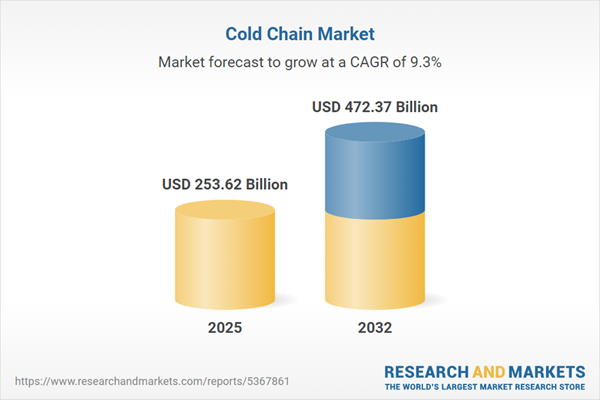Speak directly to the analyst to clarify any post sales queries you may have.
Effective cold chain management is increasingly critical for organizations navigating complex global supply chains. As regulatory pressures mount and operational risks evolve, forward-thinking executives rely on rigorous market research to inform strategic investment and competitive positioning in temperature-controlled logistics.
Market Snapshot: Cold Chain Market Size & Growth
The global cold chain market is experiencing significant expansion, with market value projected to climb from USD 232.44 billion in 2024 to USD 253.62 billion in 2025. Looking further ahead, industry forecasts show continued acceleration, driven by regulatory compliance requirements, advancing technologies, and proliferating international trade. By 2032, market value is anticipated to reach USD 472.37 billion, representing a compound annual growth rate (CAGR) of 9.26%. The main drivers include the rise in demand for pharmaceuticals, food, and chemicals, along with advancements in temperature-controlled logistics and cross-border supply transparency. Enterprises within these sectors are responding by elevating their focus on robust cold chain capabilities, ensuring supply integrity and compliance across regions.
Scope & Segmentation of the Cold Chain Market
This comprehensive report provides segment-level intelligence and technology insights tailored for C-suite strategy and operations:
- Temperature Range: Includes analysis of controlled ambient, refrigerated, frozen, and cryogenic segments, each addressing sector-specific regulatory considerations and product sensitivity requirements.
- Equipment Type: Details the spectrum of cold storage rooms, advanced refrigeration systems, insulated containers, and industrial freezers that form the backbone of stable cold chain infrastructure globally.
- Service Model: Examines deployment of Internet of Things systems, GPS and RFID tracking, optimized packaging, and integrated transport networks to support real-time traceability.
- End User: Explores distinct needs of healthcare, pharmaceutical, chemical, and food and beverage markets, each of which is shaped by its own compliance demands and logistical challenges.
- Distribution Channel: Reviews leading fulfillment structures from in-house operations to external third- and fourth-party logistics providers, supporting scalability and supply chain specialization.
- Regional Coverage: Presents geographic insights on adoption patterns, investment priorities, and evolving regulations in the Americas, Europe, Asia-Pacific, and Middle East and Africa, highlighting infrastructure strengths and growth dynamics.
- Key Companies Analyzed: Evaluates the strategies and market presence of players including Kuehne + Nagel International AG, DSV Panalpina A/S, United Parcel Service of America, FedEx Corporation, CEVA Logistics AG, Agility Public Warehousing Company K.S.C.P., Americold Real Estate Investment Trust, NICHIREI CORPORATION, Sonoco ThermoSafe, and Wabash National Corporation. These profiles support executive benchmarking of operational performance and innovation leadership.
Cold Chain Market: Key Takeaways for Senior Decision-Makers
- Internet of Things and real-time monitoring are enabling full visibility across supply chains, supporting fast response to risk and continuous product quality.
- Process automation and predictive analytics in logistics are streamlining compliance, improving transparency, and safeguarding sensitive shipments.
- Effective collaboration between logistics, packaging, and data providers helps organizations implement adaptive risk management and share critical knowledge.
- Energy-efficient solutions and renewable energy integration within cold chain operations are elevating organizational sustainability and supporting corporate responsibility goals.
- Agile leadership and the use of flexible procurement models help companies navigate changing regulations and shifting market conditions, ensuring operational continuity.
United States Tariff Impact for 2025
Recent shifts in US tariff policy are prompting cold chain service providers to reassess and revise procurement, contracting, and delivery approaches. The adoption of flexible contracts, consolidated shipping solutions, and contingency planning is reinforcing stability and helping organizations maintain service reliability during regulatory adjustments.
Methodology & Data Sources
Research findings derive from secondary analysis, interviews with senior industry stakeholders, and focused workshops. This methodology ensures relevance for executive decision-making and supports holistic enterprise risk assessment and strategy formulation.
Why This Report Matters
- Equips leaders to set priorities for sustainable innovation and digital transformation, supporting ongoing compliance and organizational resilience in cold chain operations.
- Provides actionable guidance for adapting to shifting regulatory environments and leveraging technology to optimize logistics performance.
- Delivers detailed segmentation and market clarity by region, empowering decision-makers to benchmark effectively and evaluate global market entry strategies.
Strategic Conclusion
Success in the evolving cold chain sector will rely on adopting advanced technologies, designing agile logistics frameworks, and prioritizing regulatory compliance to ensure adaptability and long-term stability.
Additional Product Information:
- Purchase of this report includes 1 year online access with quarterly updates.
- This report can be updated on request. Please contact our Customer Experience team using the Ask a Question widget on our website.
Table of Contents
3. Executive Summary
4. Market Overview
7. Cumulative Impact of Artificial Intelligence 2025
Companies Mentioned
The companies profiled in this Cold Chain market report include:- Kuehne + Nagel International AG
- DSV Panalpina A/S
- United Parcel Service of America, Inc.
- FedEx Corporation
- CEVA Logistics AG
- Agility Public Warehousing Company K.S.C.P.
- Americold Real Estate Investment Trust
- NICHIREI CORPORATION
- Sonoco ThermoSafe
- Wabash National Corporation
Table Information
| Report Attribute | Details |
|---|---|
| No. of Pages | 196 |
| Published | October 2025 |
| Forecast Period | 2025 - 2032 |
| Estimated Market Value ( USD | $ 253.62 Billion |
| Forecasted Market Value ( USD | $ 472.37 Billion |
| Compound Annual Growth Rate | 9.2% |
| Regions Covered | Global |
| No. of Companies Mentioned | 11 |









